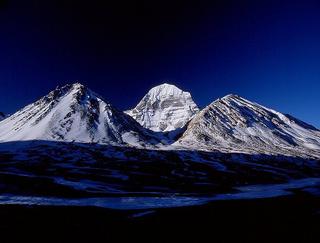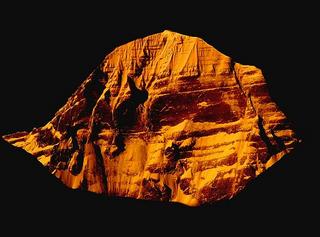Kailash Mansarovar ... A place I love to be next year...

Kailash is a rather small member of the Himalayas. They are the youngest of the earth's visible mountains, growing at the rate of several centimeters every year, as India, the sub-continent and former island moves inexorably inland. The name of this stupendous range stems from Himavat, the father of Lord Shiva's bride, Parvati. The Himalayas or abodes of snow are considered the mystical dwellings of Gods from ancient times. Ancient texts such as the Ramayana, the Mahabharata, the Puranas and the Vedas, all sing in unison of the glory and wonder of the Himalayas. The Ramayana says, "There is no mountain like Himachal, for in it are Kailash and Mansarovar. As the dew is dried up by the morning sun, so are the sins of mankind by the sight of Himachal."
Significance
Hindu mythology recognises Mt. Kailash as the only abode of the gods that can be visited by man in his mortal body. It is the earthly manifestation of Mt. Meru, the great mountain at the centre of the universe around which the whole creation revolves. While Brahma resides in Brahma Lok and Vishnu in Vaikunth, Shiva resides on Mount Kailash in a state of perpetual meditation, generating the spiritual force that sustains the cosmos. According to the Ram Charitra Manas, it was here that Shiva related the story of Ramayana to Parvati. Mount Kailash is also the residence of Kubera, God of Wealth. It is believed that Ganesha and Karthikeya both came into being on the Mandhata Mountain here. The offspring of Shiva and Parvati, along with other saintly and accomplished beings, able to grant the wishes of those living below, reside in these supreme mountains.
Vaikunth, Shiva resides on Mount Kailash in a state of perpetual meditation, generating the spiritual force that sustains the cosmos. According to the Ram Charitra Manas, it was here that Shiva related the story of Ramayana to Parvati. Mount Kailash is also the residence of Kubera, God of Wealth. It is believed that Ganesha and Karthikeya both came into being on the Mandhata Mountain here. The offspring of Shiva and Parvati, along with other saintly and accomplished beings, able to grant the wishes of those living below, reside in these supreme mountains.
Om Namah Shivaya
Virtual

 Vaikunth, Shiva resides on
Vaikunth, Shiva resides on 
 Vaikunth, Shiva resides on
Vaikunth, Shiva resides on
0 Comments:
Post a Comment
<< Home